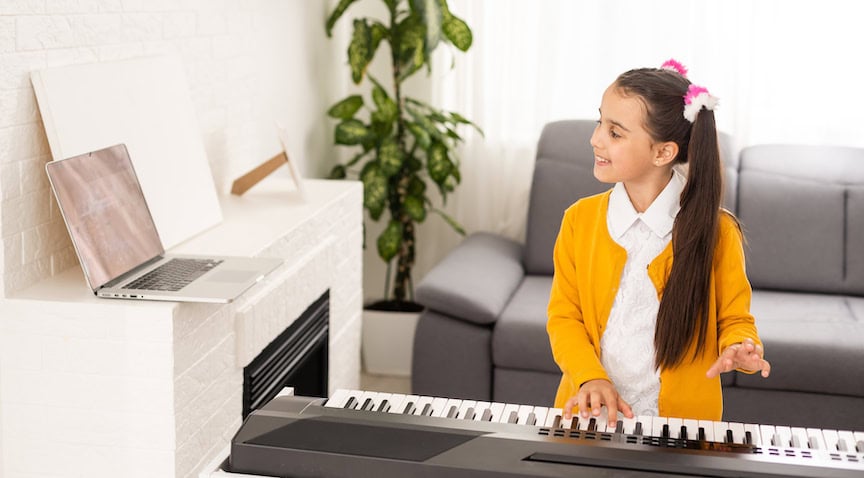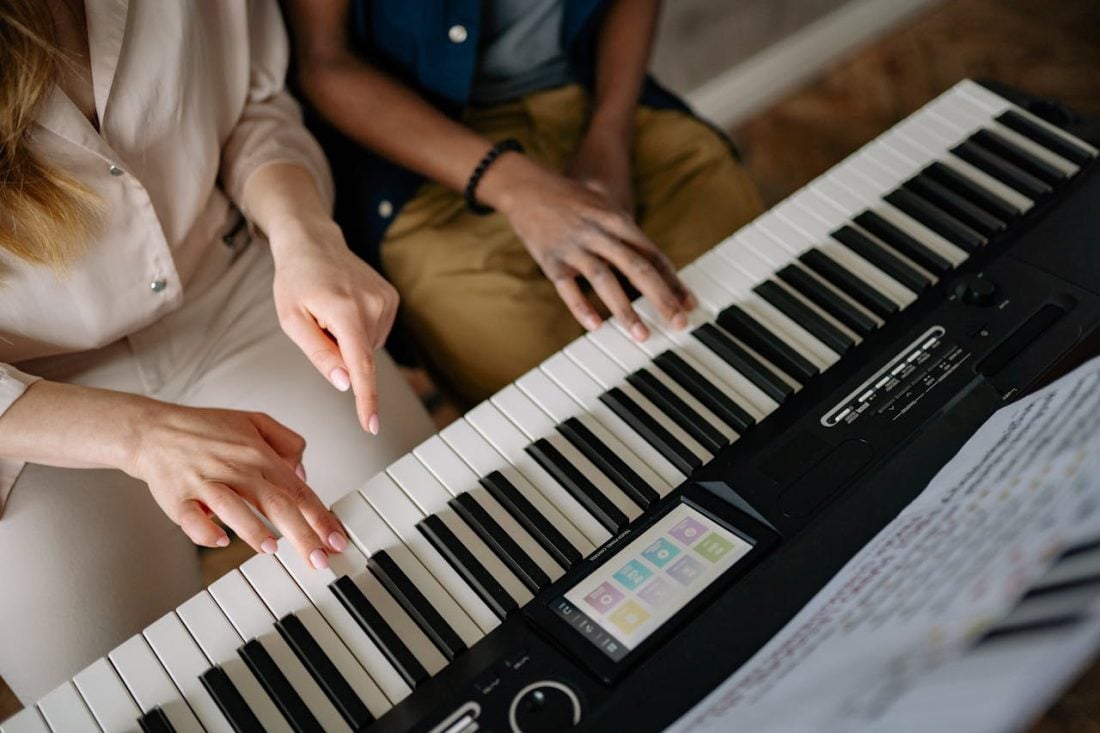4 Creative Music Improvisation Activities for Piano Students
This post may contain affiliate links. If you purchase something through an affiliate link, I will receive a small commission at no cost to you. For more information, read the disclosure statement here.

There are so many fun music improvisation activities you can use with your piano students!
Over the last few months, we’ve written a blog series all about teaching improvisation, so if you’re new to music improvisation activities for piano students, you’ll want to check out all of our previous blog posts too:
- 5 Good Reasons To Teach Piano Students How To Improvise
- 3 Advantages of Using Games to Teach Piano Improv
- Using Games to Teach Piano Students to Improvise
- 10 Tips for Using Games to Teach Improvisation to Students
Once your student has been introduced to improvisation, you can expand their music improvisation activities to so much more!
So far, our blog post series has focused on using music spelling words to guide your student with improvisation.
However, there are lots of other music improvisation activities we can do in piano lessons to teach piano students how to improvise.
Here are 4 fun ideas that will expand their improvisation experience from notes to rhythm, chords, collaboration, and composition!

1. Rhythm Music Improvisation Activities
Ask your students to improvise a rhythm using different time signatures.
For example, you could ask them to improvise a rhythm using a 3/4 time signature or a 7/8 time signature.
Use music rhythm flashcards to line up a one-measure rhythm for your student to improv with.
If your student is timid, have them start with tapping the rhythm out on one single pitch.
Then, guide them to experiment with that rhythm and a pentascale.
As the student learns the rhythm, challenge them to vary the notes they’re using. Maybe they can create a sequence, play the idea low then high, or play it with their left hand playing a third below the right hand.
You don’t have to wait until your student understands time signatures and complex rhythm to do rhythm music improvisation activities.
If you’re working with young students, use Preschool Rhythm Activity Cards. They can say the names of the animals as they create a cute little song on different pitches!
Rhythm music improvisation activities not only help your student gain confidence in improv, but it also helps them build experience in accurate rhythms.
2. Chord Progression Improvisation Activities
Have your students improvise a chord progression using the words on the Music Spelling Bee cards (watch our introduction for how to improvise with Music Spelling Bee Cards here). You can provide them with a set of chords or let them create their own.
For example, the Music Spelling Bee Card for “FED” can be F major, E major, and D major OR F major, E minor, and D minor.
Your younger students may stick with white-key chords while your older students can play around with the chords they know (even diminished, augmented, and seventh chords!).
Using each note as the root of the chord will give your student plenty of room to experiment.
Once they have a chord progression, they can play it arpeggiated on the entire piano, come up with a left hand pattern they love and add an original melody to the right hand, or anything else that strikes their fancy!
The most important thing to remember is that there are no incorrect answers. Allow your students the freedom to explore chords in any way they choose (they can even choose to do some cluster chords or suspended chords).
3. Improvisation Duets

Pair your students up and have them take turns with one student improvising using the words on the Music Spelling Bee cards while the other plays a simple accompaniment also based on that word.
You may want to prepare some fitting chords for each word to guide your accompaniment student. A simple cadence can go a long way!
If chords are too complicated for your second student, then you can put your improv student on the piano (with a Music Spelling Bee card) and your accompaniment student on a rhythm instrument.
Or, you can have two single melody-lines going at the same time with each student doing their own improv on the same notes and see what it sounds like!
Duet music improvisation activities can help your students develop their listening and improvisation skills while also encouraging collaboration, which is such an important part of music making.
4. Improvised Theme And Variations
Challenge your students to improvise not only a melody, but also variations of that melody based on the words on the Music Spelling Bee cards.
You can provide your student a list of variation ideas to work from such as:
- Change your melody rhythm
- Play your melody in different octaves
- Add trills to your melody
For your more advanced students who can also add chords to their improv melodies, they can add variation by changing up their left hand patterns or putting the melody in the left hand while the right hand chords.
Theme and Variations music improvisation activities can challenge your students’ creativity and encourage them to explore different ways to interpret a musical idea.
What Are Your Favorite Music Improvisation Activities?
Have you tried any of these ideas before? Or are there other music improvisation activities you love doing? I’d love to hear what has worked for you and your students in improvisation! Comment and share!
More Creative Blog Posts You’ll Love…
Don't miss out!
Follow on Facebook and Instagram, join the best Facebook group for piano teachers, and subscribe to the newsletter to get helpful teaching tips, resources, and tutorials delivered straight to your inbox every week.
Amanda Tero
Amanda Tero
Welcome!

Hi! I’m Melody Payne, a pianist and piano teacher, educational resource author, a fun-loving wife to the most wonderful and talented hubby I could ask for, and a lifelong learner who loves to share. I want to make your life as a music teacher easier by writing and sharing helpful and relevant music teaching articles, and by creating educational resources with your very own students in mind. If you are a parent who wants to enroll your child in piano lessons, I’d love for us to get started building those skills that can give your child a lifetime of musical enjoyment!

